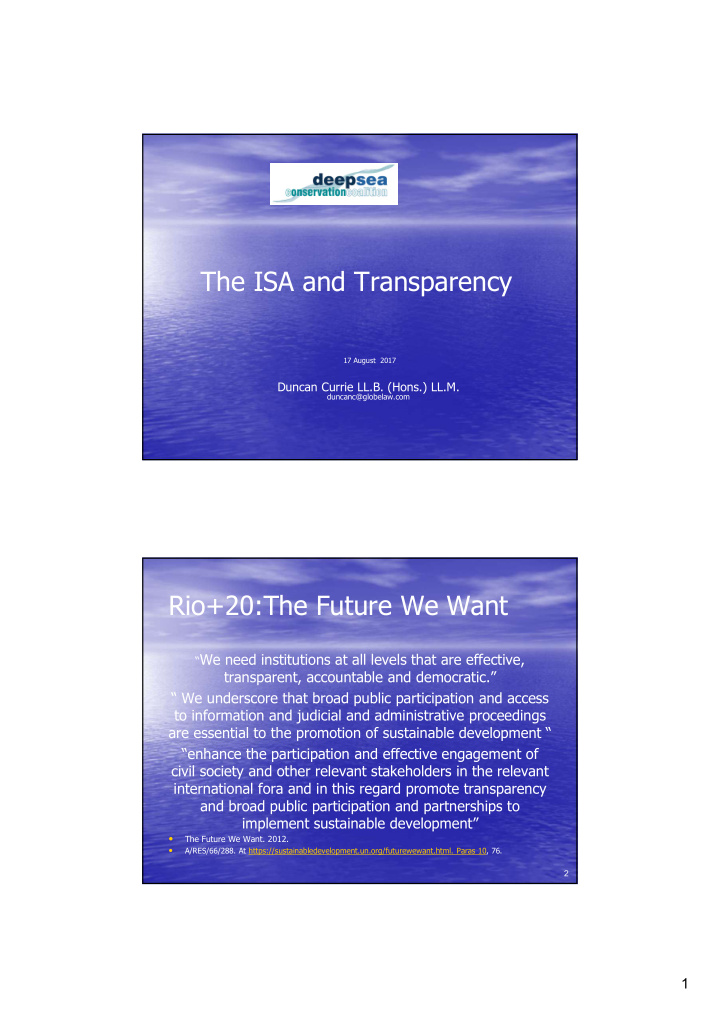



The ISA and Transparency 17 August 2017 Duncan Currie LL.B. (Hons.) LL.M. duncanc@globelaw.com Rio+20:The Future We Want “ We need institutions at all levels that are effective, transparent, accountable and democratic.” “ We underscore that broad public participation and access to information and judicial and administrative proceedings are essential to the promotion of sustainable development “ “enhance the participation and effective engagement of civil society and other relevant stakeholders in the relevant international fora and in this regard promote transparency and broad public participation and partnerships to implement sustainable development” • The Future We Want. 2012. • A/RES/66/288. At https://sustainabledevelopment.un.org/futurewewant.html. Paras 10, 76. 2 1
Sustainable Development Goals SDG 14 Call to action: We reaffirm our commitment to the implementation of Goal 14 with the full participation of all relevant stakeholders. SDG 16. Promote peaceful and inclusive societies for sustainable development, provide access to justice for all and build effective, accountable and inclusive institutions at all levels 16.7 Ensure responsive, inclusive, participatory and representative decision-making at all levels 6.6 develop effective, accountable and transparent institutions at all levels 3 Transparency and Procedural Mechanisms Transparency: Aarhus Convention – Access to information – Public participation – Review procedures 4 2
Access to Information • Information on claims, contracts, environmental information, environmental baselines, impact assessment, procedures, annual and monitoring reports Documents relevant to development of Plans of Work including: • baseline data • Scoping reports • environmental impact assessments and statements • environmental management plans • Monitoring Subject only to commercial confidentiality, which is strictly defined and subject to review procedures. 5 Access to Information • UNCLOS art 163.8, 168.2 Secretariat, LTC member: shall not disclose, even after the termination of their functions, any industrial secret, proprietary data which are transferred to the Authority in accordance with Annex III, article 14, or any other confidential information coming to their knowledge • Annex III Art 14.2: Data necessary for the formulation by the Authority of rules, regulations and procedures concerning protection of the marine environment and safety, other than equipment design data, shall not be deemed proprietary. • The definition and identification of non-proprietary data crucial. • ISA Secretariat Note in 2016 recommended formal decision to apply additional procedures for the handling of confidential data and information. SBA/22/LTC/6 Procedures for the handling of confidential data and information pursuant to rule 12 of the rules of procedure of the Legal and Technical Commission. 6 3
Public Participation • Access by accredited observers to meetings of all governing bodies, including the Assembly, the Council and the Legal and Technical Commission, and any subsidiary bodies • Which should be open unless specifically closed for defined purposes, unless there is a reasonable basis to exclude such participation (such as when matters of commercial confidence are being discussed) according to transparent and clearly stated standards that are made available in advance. • Access would involve reasonable opportunities to participate in environmental impact assessment hearings, such as the ability to produce scientific evidence and experts and make submissions on EIA, EMMP and other matters, as well as in any review hearings. • Techniques such as video conferencing would facilitate participation • Confidentiality agreements for proprietary data 7 Interested Persons CCZ Environmental Management Plan: Transparency . The Authority shall enable public participation in environmental decision-making procedures in accordance with the Convention on Access to Information, Public Participation in Decision- Making and Access to Justice in Environmental Matters, 1998, and its own rules and procedures. Aarhus Art 2 • “The public concerned ” means the public affected or likely to be affected by, or having an interest in, the environmental decision- making; for the purposes of this definition, non-governmental organizations promoting environmental protection and meeting any requirements under national law shall be deemed to have an interest. • Art 134 The Area and its resources are the common heritage of mankind. • Who is affected in ABNJ? CHM must mean all public have interest or are affected 8 4
Regulations: Definition Current draft : Definition: Stakeholders should be “Interested Person(s)” defined simply as persons “means a natural or having an interest of any juristic person or an kind in the Area. association of persons Stakeholders should be that, in the opinion of open-ended due to the the Authority, is directly Area being both beyond affected by the carrying national jurisdictions and out of Exploitation due to its status as the Activities in the Area or common heritage of who has relevant mankind. 9 information or expertise Procedural Needs • Recommendation 16 – The Legal and Technical Commission should be encouraged to hold more open meetings in order to allow for greater transparency in its work. • Arguments for not holding open meetings: – “It’s regulatory” –much is legislative eg regulations, but even so, it’s international so international practice – It’s confidential – sign agreements; close if confidential – It inhibits discussion – it enhances it, and see precedent at start of presentation. Good governance. 5
Procedural Needs • Process: clear, transparent, timelines • Including workshops, subcommittees etc • Applications: transparent, comprehensive and fair evaluation • EIAs: independent scientific review, public, comment • Regular reviews • Review procedures – Espoo Implementation Committee, Aarhus Compliance Committee 6
Recommend
More recommend